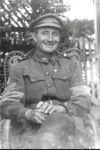The Gallipoli Landing
contributed by Michael Hall
Ernest Murray grew up at Michelago and Bredbo, helping his father, John, work various gold mines. His family moved to Canberra in 1909 where John Murray operated a bakery and store in the middle of what is today Commonwealth Park. About the same time Tom Newson migrated from Ipswich in England. He arrived in Canberra in 1911 to work as a carpenter. When the Great War began both Murray and Newson enlisted with the 1st Field Company Engineers. Both have the distinction of being amongst the first Australians to land on Gallipoli. The engineers had responsibility for cutting the wire and demolishing defensive works and guns at the landing. Murray recorded in his diary that they “landed at 4.30am amid a perfect hell of lead fired when we were 200 yards away” and “we charged through until we were only 10 yards away from the enemy”. The “infantry charged magnificently” according to Murray “and drove the Turks back over one mile by midday. Shrapnel on landing and heavy firing continued all day, but the operations were carried out splendidly”. “I will never forget that morning as long as I live”, wrote Newson. “We all shouted till we were hoarse, and we were all drenched to the skin”. Newson remembered getting to within 100 yards of the shore when the Turks “sent rockets up and a terrific fire opened on us and the beach was ablaze with rifle fire”. They pulled in as close to the step cliffs as possible “until our boats touched the rocks and we all fixed bayonets. We were not allowed to load our rifles, and then jumped overboard and waded ashore. Our boat was the first to land”. They “had a great struggle getting ashore, as we were falling down all the time slipping on the submerged rocks and round stones, and a terrible lot of our men were shot down before we reached shore. It was impossible to give any orders but every man for himself, and with a yell we charged with bayonets to get the Turks on the go”. “When I look back” said Murray, “and see the service we did in the first few days after landing it seems almost incredible that we could have done it at all. It must have been the danger and excitement that kept us going”. Newson was awarded the Distinguished Conduct Medal for his work on Gallipoli and was also Mentioned in Despatches. He was wounded at Poziéres and spent the remainder of the war as a mechanic with the Australian Flying Corp. Murray transferred to the 14th Field Company Engineers after the Gallipoli campaign and served at Fromelles, Bullecourt and Polygon Wood where he earned the Military Medal and bar. He was wounded early in 1918 and returned to Australia where he obtained a soldier settlers block near Fyshwick and Narrabundah. He died of leukemia in 1935 and is buried in St. John’s churchyard, Reid. |
|



